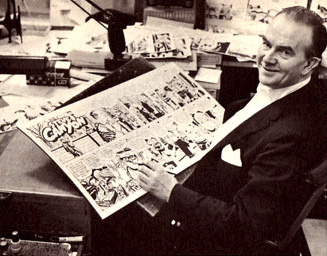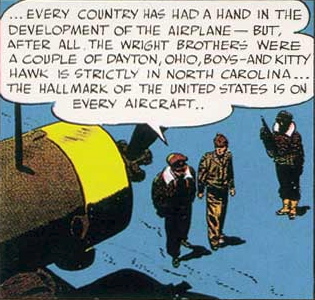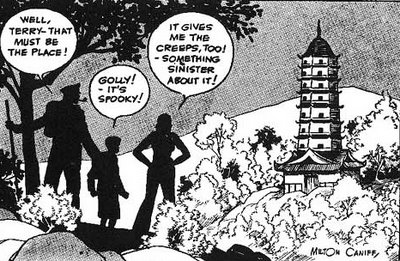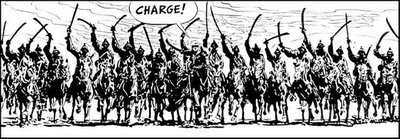Milton Caniff: Remembering The Rembrandt Of The Comics
by Neal Romanek & Glenn Romanek
Last week, San Diego Comic-Con International 2007 celebrated the 100th anniversary of the birth of comic strip artist Milton Caniff. It's interesting to note that of the most talked about presentations of the entire 4 day convention was the panel on the new "Indiana Jones IV" movie. I wonder how many attendees knew that without a man named Milton Caniff, Indiana Jones would never have existed.
Milton Caniff, creator of "Terry & the Pirates" and "Steve Canyon" was already winding down his career when I first heard of him. Yet Milton Caniff's work has been an inspiration for artists, writers, filmmakers for half a century. My own knowledge of the artist came via my dad who grew up with newspaper comic strips. My dad was inspired by Caniff's work to study art at Ohio University. It's not far off to say that Milton Caniff is a kind of great-grandfather – to me and, whether they know it or not, to many, many other action-adventure authors & artists working today.
Filmmakers, illustrators, comic authors are part of a long heritage of pictorial storytelling, and knowing where you've come from is at least as important as knowing where you're going.
So, to write an observance of the 100th birthday of Milton Caniff, I asked my dad about his hero:
Milton Caniff? My favorite. And the best. Rembrandt of the Comic Strips.
Some might argue the greatest newspaper comic strips were "The Yellow Kid", "Little Nemo", "Krazy Kat". But there should be no doubt about who was the greatest artist - Milton Caniff, hands down. Hal Foster’s name crowds Caniff’s at the top. But Foster himself told Caniff, “I’d be the best comic strip artist in America if you'd quit stepping on my fingers.” And Foster had a week to draw his beautiful page and write his great story. Caniff had to grind out a full page Sunday strip and six dailies day after day, week after week, year after year for over forty years.
You know that I lived with a lot of relatives -- “extended family” they call it -- in a coal mining company house in Depression Era West Virginia. Cheap but dirty. Sunday morning became a cat and dog fight about who, after a big pancake and sausage breakfast, would read The Funnies first.
I don’t recall seeing a comic page until I was five, but I seem to remember "Thimble Theater". I suppose I was looking over a shoulder of a relative who was reading the Sunday “Funnies“. I was fascinated by them. I didn’t know who drew anything.
In ‘37, Hal Foster's "Prince Valiant" came out, and I was hooked and was never let go. I read all of The Funnies: "Buck Rogers", "Dan Dunn", "Wash Tubbs", "Captain and the Kids", "Bringing Up Father", "Thimble Theater", "Toonerville Trolley", "The Gump’s", "Tillie the Toiler", "Little Orphan Annie", even "Ella Cinders". And "Flash Gordon" and "Tarzan" - I couldn’t get enough of those two. I couldn’t read the balloons, but I got the picture; fascinated, carried away in a beautiful dream.
I was twelve when I found Milton Caniff' and his Far East adventure “Terry and the Pirates”.
We had moved to Akron, Ohio, like many other West Virginians who migrated to find jobs in the "Rubber Capital of the World" after the US entered World War II. Along with "Dick Tracy" and "Abby and Slats", I discovered "Terry and the Pirates" in the Akron Beacon Journal.
 Talk about hooked! I could hardly wait for the next day’s episode. Always exciting, always suspenseful and satisfying. And excellent writing, superb draftsmanship, never surpassed. Milton Caniff was a brush and ink man: Yes, Rembrandt of the Comic Strips. Dark and light; nearly 3-D. Have you looked at Rembrandt’s lightning-brushed wash drawings?
Talk about hooked! I could hardly wait for the next day’s episode. Always exciting, always suspenseful and satisfying. And excellent writing, superb draftsmanship, never surpassed. Milton Caniff was a brush and ink man: Yes, Rembrandt of the Comic Strips. Dark and light; nearly 3-D. Have you looked at Rembrandt’s lightning-brushed wash drawings?Caniff said that the strip's suspense helped sell newspapers; and he was amply rewarded. I read, when he started "Steve Canyon", he was making 100,000 bucks or so a year, a pretty good pile sixty years ago - can it be 60 years!
Both Terry and Canyon always came across as people you could meet and know, and with whom you could easily imagine traipsing around the world and outwitting the bad guys – not to mention having Burma and Sumer Smith as girl friends. And Dragon Lady. And Copper Calhoon. And Madam Lynx.
You know, no comic strip artist has ever matched the sexiness of Caniff’s female characters. Compare the big boobs and butts of 90% of artists out there to Caniff’s realistic sirens. They’re not paper dolls. They live and breathe. And in sheer variety and number of characters alone, Caniff gets the nod over other comic authors.
I’m still in love with Burma, Copper Calhoun, and a couple of others; and maintain an unwise lust for Cheetah. True, "Prince Valiant's" Aleta of the Misty Isles was beautiful - Botticelli beautiful - and Dale in "Flash Gordon" was a dish well served on Mongo or elsewhere, but the intangible touch of self-revealed intimacy of Caniff's women is matchless. A few inches in front of your nose, up close and personal, is better than up on a pedestal - or a spaceship.
 Even during WWII, Caniff rarely stooped to overt propaganda, and never made the bad guys cartoonish caricatures. In "Terry", the Invaders – essentially the Japanese who invaded China prior to World War II -- and later the Japanese enemy during the War, were drawn realistically. “Die! You dirty sons of Nippon!” was for the propaganda movies and comic books.
Even during WWII, Caniff rarely stooped to overt propaganda, and never made the bad guys cartoonish caricatures. In "Terry", the Invaders – essentially the Japanese who invaded China prior to World War II -- and later the Japanese enemy during the War, were drawn realistically. “Die! You dirty sons of Nippon!” was for the propaganda movies and comic books.Early in his career, when Caniff worked for the Columbus Dispatch, he told an editor that he wanted to be an actor. The guy told him, “Stick to your ink pots, kid. Actors don’t eat regular.” Caniff didn’t become an actor, but he became a marvelous director!
I have a strong suspicion George Lucas and Steven Spielberg have looked closely at Caniff's work. Indiana Jones is a descendent of Pat Ryan, and "Empire Of The Sun" conjures an unsavory flipside of "Terry and the Pirates". But Indiana Jones’s breathless escapes are pure comic books. Caniff's stories become full-bodied adventures in romance and realism.
 When "Steve Canyon" began in 1947 – the same year the US Air Force was founded - I started to save all of its strips. I discovered that the best Sunday strip was on the front comic page of the New York Mirror. I don’t why, but the color was more intense than any other I knew about, and seemingly was a crisper print.
When "Steve Canyon" began in 1947 – the same year the US Air Force was founded - I started to save all of its strips. I discovered that the best Sunday strip was on the front comic page of the New York Mirror. I don’t why, but the color was more intense than any other I knew about, and seemingly was a crisper print.Both Terry and Steve Canyon were both in the Air Force at one time or another. Steve was a pilot in World War II. When he became a civilian, he started a small operation air service – "Horizons Unlimited". After a considerable number of adventures, he again became an officer in the United States Air Force.
There was a continuing patriotism in Caniff's work. He had volunteered to join the Army, but because of his physical disabilities, was not accepted. He was a “bleeder”, you know. I read years ago that he said "A knock on my leg could knock me off." Caniff did a lot of art work for the US government -- in particular, the Air Force -- gratis. I have no doubt his work helped influence many to join it. And he would write and draw special strips for events such as Armed Forces Day, Veterans Day, etc.
You know that I was in SAC in the Air Force for 20 years, was on B-52 alert during the Cuban Missile Crisis, and flew a considerable number of 24- hour missions with nuclear weapons on board. I can’t pinpoint the particular episodes or times, but a realistic ambience of the Cold War permeated "Steve Canyon". Milton Caniff had a feel for life. All aspects of it.
Toward the end of Caniff's life, in appreciation for Steve Canyon's many contributions to the Air Force and his country, the US government officially gave the Canyon character his own personal Service Number. Quite a tribute to Caniff.
Like a slow death, the last few years of Steve Canyon lost its energy and beauty. The size of the panels was reduced. The drawing and inking was tentative, and Steve would dream of being in the American Revolution or some other incongruous historical experience. I think Caniff let others do most of the work, and perhaps guided the story and penciled some of the action, but I don’t know.
Also, he was approaching eighty years of age
All lovers of comics should be forever grateful the kid stuck to his ink pots.
Labels: comics and illustration



